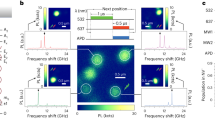Abstract
Photorefractive materials are being widely investigated for applications in holographic data storage1. Inhomogeneous illumination of these materials with an optical interference pattern redistributes charge, builds up internal electric fields and so changes the refractive index. Subsequent homogeneous illumination results in light diffraction and reconstructs the information encoded in the original interference pattern. A range of inorganic and organic photorefractive materials are known2, in which thousands of holograms of high fidelity can be efficiently stored, reconstructed and erased. But there remains a problem with volatility: the read-out process usually erases the stored information and amplifies the scattered light. Several techniques for ‘fixing’ holograms have been developed3,4,5,6, but they have practical disadvantages and only laboratory demonstrators have been built7,8,9,10. Here we describe a resolution to the problem of volatility that should lead to the realization of a more practical system. We use crystals of lithium niobate — available both in large size and with excellent homogeneity — that have been doped with two different deep electron traps (iron and manganese). Illumination of the crystals with incoherent ultraviolet light during the recording process permits the storage of data (a red-light interference pattern) that can be subsequently read, in the absence of ultraviolet light, without erasure. Our crystals show up to 32 per cent diffraction efficiency, rapid optical erasure of the stored data is possible using ultraviolet light, and light scattering is effectively prevented.




Similar content being viewed by others
References
Psaltis, D. & Mok, F. Holographic memories. Sci. Am. 273, 70–76 ((1995)).
Meerholz, K., Volodin, B. L., Sandalphon, Kippele B. & Peyghambarian, N. Aphotorefractive polymer with high optical gain and diffraction efficiency near 100%. Nature 371, 497–500 (1994).
Amodei, J. J. & Staebler, D. L. Holographic pattern fixing in electro-optic crystals. Appl. Phys. Lett. 18, 540–542 (1971).
Micheron, F. & Bismuth, G. Electrical control of fixation and erasure of holographic patterns in ferroelectric materials. Appl. Phys. Lett. 20, 79–81 (1972).
von der Linde, D., Glass, A. M. & Rodgers, K. F. Multiphoton photorefractive processes for optical storage in LiNbO3. Appl. Phys. Lett. 25, 155–157 (1974).
Külich, H. C. Anew approach to read volume holograms at different wavelengths. Opt. Commun. 64, 407–411 (1987).
Heanue, J. F., Bashaw, M. C., Daiber, A. J., Snyder, R. & Hesselink, L. Digital holographic storage system incorporating thermal fixing in lithium niobate. Opt. Lett. 21, 1615–1617 (1996).
Ma, J. et al. Electrical fixing of 1000 angle-multiplexed holograms in SBN:75. Opt. Lett. 22, 1116–1118 (1997).
Lande, D., Orlov, S. S., Akella, A., Hesselink, L. & Neurgaonkar, R. R. Digital holographic storage system incorporating optical fixing. Opt. Lett. 22, 1722–1724 (1997).
Chuang, E. & Psaltis, D. Storage of 1000 holograms with use of a dual-wavelength method. Appl. Opt. 36, 8445–8454 (1997).
Kurz, H. et al. Photorefractive centers in LiNbO3studied by optical, Mössbauer- and EPR-methods. Appl. Phys. 12, 355–368 (1977).
Guenther, H., Wittmann, G., Macfarlane, R. M. & Neurgaonkar, R. R. Intensity dependence and white-light gating of two-color photorefractive gratings in LiNbO3. Opt. Lett. 22, 1305–1307 (1997).
Staebler, D. L. & Phillips, W. Hologram storage in photochromic LiNbO3. Appl. Phys. Lett. 24, 268–270 (1974).
Ming, Y., Krätzig, E. & Orlowski, R. Photorefractive effects in LiNbO3:Cr induced by two-step excitations. Phys. Status Solidi A 92, 221–229 (1985).
Thiemann, O. & Schirmer, O. F. Energy levels of several 3d impurities and EPR of Ti3+ in LiNbO3. Proc. SPIE 1018, 18–22 (1988).
Buse, K., Holtmann, L. & Krätzig, E. Activation of BaTiO3for infrared holographic recording. Opt. Commun. 85, 183–186 (1991).
Mok, F. H., Burr, G. W. & Psaltis, D. System metric for holographic memory systems. Opt. Lett. 21, 896–898 (1996).
Acknowledgements
We thank E. Krätzig for discussions. This work was supported by JPL, funded by DARPA/ITO, and by grants from Rome Labs. K.B. thanks the Deutsche Forschungsgemeinschaft for a postdoctoral fellowship.
Author information
Authors and Affiliations
Corresponding author
Rights and permissions
About this article
Cite this article
Buse, K., Adibi, A. & Psaltis, D. Non-volatile holographic storage in doubly doped lithium niobate crystals. Nature 393, 665–668 (1998). https://doi.org/10.1038/31429
Received:
Accepted:
Issue Date:
DOI: https://doi.org/10.1038/31429
- Springer Nature Limited
This article is cited by
-
Tunable liquid crystal grating based holographic 3D display system with wide viewing angle and large size
Light: Science & Applications (2022)
-
Bound polaron formation in lithium niobate from ab initio molecular dynamics
Applied Physics A (2022)
-
In-plane quasi-single-domain BaTiO3 via interfacial symmetry engineering
Nature Communications (2021)
-
High efficiency holographic Bragg grating with optically prolonged memory
Scientific Reports (2016)
-
Interference and holography with femtosecond laser pulses of different colours
Nature Communications (2015)





